DID BROOKLYN GIRLS SMOKE? (1887)
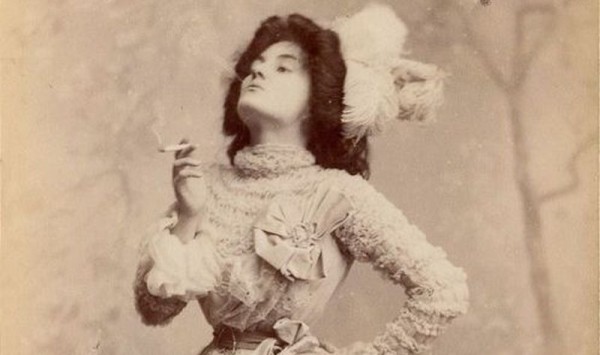
******************************************************************************************************************************** Brownstone Detectives investigates the history of our clients’ homes. The story you are about to read was composed from research conducted in the course of one of those investigations. Do you know the history of YOUR house? ******************************************************************************************************************************** “There are more women in the City of Brooklyn who smoke cigarettes than any one…would ever dream of.” So floated the words of a Fulton street cigar store proprietor one evening in 1887, after a boy “of 12 or 13 years of age” entered and asked him for “a package of the same kind she got last night. “I was paid to find out why. So, going to the source, I found a few men who talked. Actually, they sang like canaries. And I kept good notes.” TRACKING A RUMOR TO ITS SOURCE The cigar store I walked into was doing a brisk business. But the customers were men. All men and, from time to time, a few boys. Playing the bored customer, I perused the tobacco boxes, fiddled with the cigar cutters, and then spotting the proprietor – rather he spotted me! – he struck up a conversation. Like most customers who either didn’t know what they were looking for or had ulterior motives, I told him that I was just browsing. Taking him into my confidence just then, I asked him where all of his female customers were. Arching an eyebrow, he shot me a knowing glance, patted the side of his nose, and waved a hand before me, […]
COULD COLORED MEN PUT OUT FIRES? (1898)
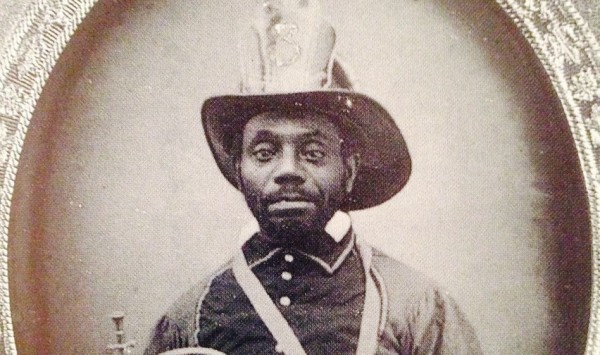
******************************************************************************************************************************** Brownstone Detectives investigates the history of our clients’ homes. The story you are about to read was composed from research conducted in the course of one of those investigations. Do you know the history of YOUR house? ******************************************************************************************************************************** In 1898, a Brooklyn – and New York City – “first” occurred when Fire Commissioner John Jay Scannell assigned the first black man to serve in the Fire Department in Brooklyn. William H. Nicholson, of No. 200 Myrtle Avenue, was a 29-year-old former cement tester who had been born in Virginia. He would become, in a number of ways, the precursor to the many first blacks to be “allowed” to integrate society’s historically “white” institutions in the century to follow. While, in 1891, Wiley G. Overton, another “colored man,” had been the first to be appointed as a patrolman on the Brooklyn police force, Nicholson, as a fireman, was still entering into a conflagration of his own. Patrolman Overton had found his existence on the force to be terminally difficult. Assigned to patrol the Brooklyn “colored district,” he had been transferred around to several precincts because no white officer would sleep in the same dormitory with him. His very presence in every station house had “caused trouble.” Finally, after being subjected to all sorts of “annoyances,” Overton had been “practically hounded from the force” a few years after his appointment. And it was likely that Nicholson knew this. Now, Nicholson had become the Fire Department’s unofficial test case for “colored integration.” […]
ROASTING CORK IN A “HEIGHTS” FIRE (1907)
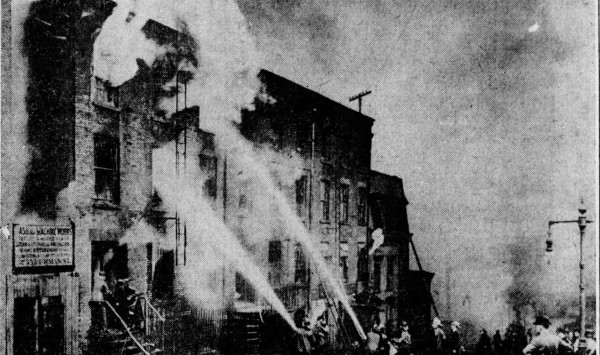
The Jehovah’s Witness complex in Downtown Brooklyn was once the scene of a roaring early morning 4-alarm fire that threatened to destroy the vast warehouse district that existed there in 1907. Sitting along the waterfront at the location of the fire – on both Columbia Heights and Furman Street – was a cork company, a coffee roasting factory, and an ice plant. SAVING THE WAREHOUSES It is not known where exactly within the complex the fire broke out, but it was determined by many of the residents of the district that the aroma of burnt coffee and cork did not make for a attractive combination that morning. The “oily reek of cork” was in the smell of the smoke throughout the morning, while roasted coffee – roasted twice over – brought residents to realize which warehouses were caught within the conflagration. The buildings in the picture above sat on what is now the Jehovah’s Witness compound and comprised a number of private homes that were still existent within the old warehouse district. Among them was “a frame house of the old style sort, two stories in height, with a mansard roof for an attic.” And in that building Catherine O’Neill, 50, and her bedridden sister, Agnes O’Neill, 65, both former “schoolma’rms,” feared for their lives. SAVING THE SCHOOLMARMS Patrolman Keating, who sounded the alarm, grew concerned as their building was shrouded in black smoke. No one had seen the two women that morning, and he “feared that something had happened to them.” So, […]
THE GREENEST BLOCK IN BROOKLYN (1902)
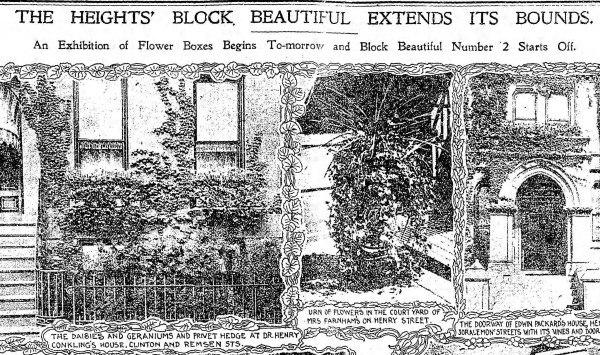
******************************************************************************************************************************** Brownstone Detectives investigates the history of our clients’ homes. The story you are about to read was composed from research conducted in the course of one of those investigations. Do you know the history of YOUR house? ******************************************************************************************************************************** As the judging for this year’s “Greenest Block in Brooklyn” award heads into its final round, we bring you a history of the concept of beautifying and greening neighborhoods in the borough of Brooklyn. A BRIEF HISTORY OF BLOCK BEAUTIFICATION IN BROOKLYN Before the Botanic Garden arrived on the scene with its “Greenest Block in Brooklyn” initiative in the 1990s, there was “Block Beautiful.” A number of private Brooklyn citizens, wishing to bring about the greening of their neighborhood, initiated an organized effort to stimulate an active interest in its residents utilizing their green thumbs to good effect. This earliest organized “block beautification” project began somewhat simultaneously in 1902 on two separate streets and section of the borough – Henry Street (in Brooklyn Heights) and on Quincy Street (in the Bedford Section). Led by Miss Zella Milhau of 291 Henry Street, the effort was called “Block Beautiful,” and was an initiative to “green” the block upon which she and her family lived, with the hope that this effort would be replicated throughout the city. Milhau, an artist and active member of the Municipal Art Society and the Fine Arts Club of Manhattan, who lived in the Columbia Heights section on Henry Street between Joralemon and State streets, originated the idea and got […]
THE NO. 8 MACHINE OF FULTON STREET (1876)
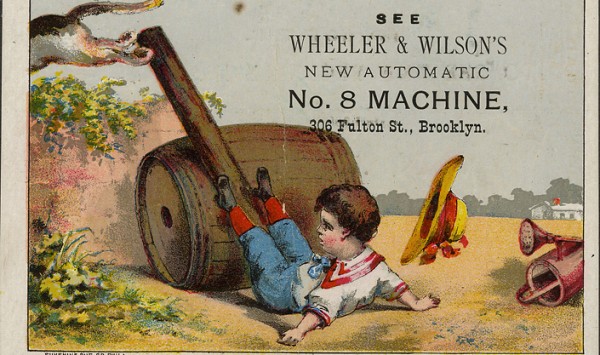
The No. 8 Machine. Such a romantic honorific. The name literally rolled off the tongue and dazzled the listener with the rhythm of its mellifluousness and style… OK. I won’t lie. It really wasn’t the sexiest of names. It sounds like a government-designed and -built outhouse. And it smells just as bad. Buyers of sewing machine back in the late 1800s, though, were really not shopping for a sexy name. They were looking for dependability and speed. Stylish sewing machines, then, were like the hotrods of the day for garment producers. Just as for the marketers of the 20th century’s Mark VI or Chrysler 300, or even the Mercedes 190-E, present-day automobile manufacturers always knew that that they “had” their buyers with their brand. They didn’t need a sexy name for their cars. They simply had to tack on the latest model number to their speed machines to let their faithful customers know that it was a new year and that they were once again out of style and out of step with the times. One of the producers of the 19th century speedster sewing machines was the Wheeler & Wilson Company. Their hotrod was the No. 8. SELLING THE NO. 8 And so with the graceful design and the smooth functioning of their No. 8 Machine, Wheeler and Wilson’s creation was on the tongues of many a manufacturer. Garment designers and clothing manufacturers literally felt something move within their hearts when they heard the No. 8 name. Wheeler and […]